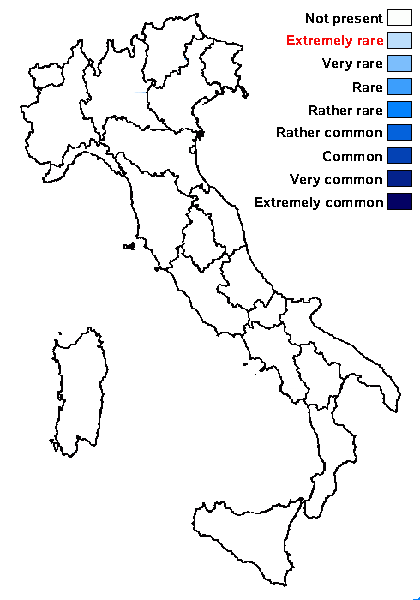Placopyrenium tatrense (Vězda) Breuss
Linzer biol. Beitr., 22, 2: 721, 1990. Basionym: Placidiopsis tatrensis Vězda - Acta Mus. Silesiae, Ser. A ,10: 4, 1961
Synonyms:
Distribution:
Description: Thallus crustose, episubstratic, areolate-subsquamulose, forming up to c. 2 cm wide patches, the areoles usually convex, contiguous, slightly constricted at base, pale brown to grey-pruinose, black on lower surface but without conspicuously black flanks, the peripheral ones elongate and more or less radiating, up to 2.5 x 1.5 mm. Cortex poorly defined, the cell walls with a brown pigment, overlain with a thick epinecral layer. Perithecia black, immersed, 5-10 per areole, c. 0.2 mm across, without an involucrellum. Exciple colourless in lower part, blackish in upper part; hamathecium of periphyses and periphysoids, interascal filaments absent; hymenial gel hemiamyloid. Asci 8-spored, clavate, I-, fissitunicate, the wall thickened above with an indistinct ocular chamber, Verrucaria-type. Ascospores (0-)1-(-2)-septate, hyaline, ellipsoid, 12-17 x 4-6 μm. Pycnidia rare, immersed, multilocular, Dermatocarpon-type. Conidia bacilliform. Photobiont chlorococcoid. Spot tests: K-, C-, KC-, P-, UV-. Chemistry: without lichen substances.Note: a species of weakly calciferous siliceous rocks, most frequent under overhangs and on steeply inclined surfaces, widespread but uncommon in the Pyrenees, the Alps, the Carpathians, the Balkan Mountains and Crimea, mainly in the upper montane to the alpine belt; to be looked for in Italy.
Growth form: Crustose
Substrata: rocks
Photobiont: green algae other than Trentepohlia
Reproductive strategy: mainly sexual

Predictive model
Growth form: Crustose
Substrata: rocks
Photobiont: green algae other than Trentepohlia
Reproductive strategy: mainly sexual

Predictive model
 Index Fungorum
Index Fungorum
 GBIF
GBIF

